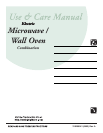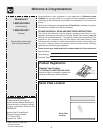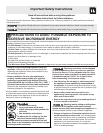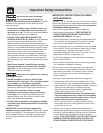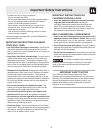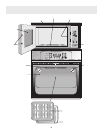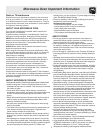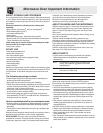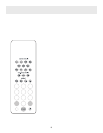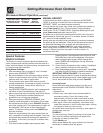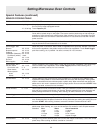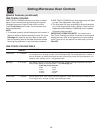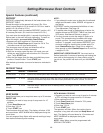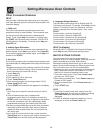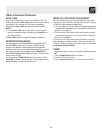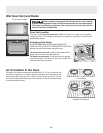
7
Microwave Oven Important Information
Radio or TV Interference
Should there be any interference caused by the microwave
oven to your radio or TV, check that the microwave oven is
on a different electrical circuit, relocate the radio or TV as far
away from the microwave oven as feasible or check position
and signal of receiving antenna.
ABOUT YOUR MICROWAVE OVEN
This Use and Care Manual is valuable: read it carefully and
always save it for reference.
A good microwave cookbook is a valuable asset. Check it for
microwave cooking principles, techniques, hints and recipes.
NEVER use the microwave oven without the turntable and
support nor turn the turntable over so that a large dish could be
placed in the microwave oven. The turntable will turn both
clockwise and counterclockwise.
ALWAYS have food in the microwave oven when it is on to
absorb the microwave energy.
When using the microwave oven at power levels below 100%,
you may hear the magnetron cycling on and off. It is normal for
the exterior of the microwave oven to be warm to the touch
when cooking or reheating.
Condensation is a normal part of microwave cooking. Room
humidity and the moisture in food will influence the amount of
moisture that condenses in the microwave oven. Generally,
covered foods will not cause as much condensation as
uncovered ones. Ventilation openings must not be blocked.
The microwave oven is for food preparation only. It should not
be used to dry clothes or newspapers.
All microwave ovens are rated by using the IEC Test Procedure
at 1200 watts. In using recipes or package directions, check food
a minute or two before the minimum time setting elapses and
add time accordingly.
ABOUT MICROWAVE COOKING
• Arrange food carefully. Place thickest areas towards outside of dish.
• Watch cooking time. Cook for the shortest amount of time
indicated and add more as needed. Food severely overcooked
can smoke or ignite.
• Cover foods while cooking. Check recipe or cookbook for
suggestions: paper towels, wax paper, microwave plastic wrap
or a lid. Covers prevent spattering and help foods to cook
evenly.
• Shield with small flat pieces of aluminum foil any thin areas of
meat or poultry to prevent overcooking before dense, thick
areas are cooked thoroughly.
• Stir foods from outside to center of dish once or twice during
cooking, if possible.
• Turn foods over once during microwaving to speed cooking of
such foods as chicken and hamburgers. Large items like
roasts must be turned over at least once.
• Rearrange foods such as meatballs halfway through cooking
both from top to bottom and from the center of the dish to the
outside.
• Use standing time. Always allow food to stand in or out of the
oven after cooking power stops. Standing time after defrosting
or cooking allows the temperature to evenly spread throughout
the food, improving the cooking results. For inside oven
standing time, you can program a “0” power stage of cooking
cycle. See Multiple Stage Cooking.
• Check for doneness. Look for signs indicating that cooking
temperatures have been reached.
Doneness signs include:
- Food steams throughout, not just at edge.
- Center bottom of dish is very hot to the touch.
- Poultry thigh joints move easily.
- Meat and poultry show no pinkness.
- Fish is opaque and flakes easily with a fork.
ABOUT FOODS
• Do not pop popcorn in your microwave oven unless in a
special microwave popcorn accessory or unless you use
popcorn labeled for use in microwave ovens.
• Some products such as whole eggs and sealed containers—
for example, closed jars—will explode and should not be
heated in this microwave oven. Such use of the microwave
oven could result in injury.
• Do not boil eggs in a microwave oven. Pressure will build up
inside egg yolk and will cause it to burst, possibly resulting in
injury.
• Operating the microwave with no food inside for more than a
minute or two may cause damage to the microwave oven and
could start a fire. It increases the heat around the magnetron
and can shorten the life of the microwave oven.
• Foods with unbroken outer “skin” such as potatoes, hot dogs,
sausages, tomatoes, apples, chicken livers and other giblets,
and egg yolks should be pierced to allow steam to escape
during cooking.
• Avoid heating baby food in glass jars, even with the lid off. Make
sure all infant food is thoroughly cooked. Stir food to distribute
the heat evenly. Be careful to prevent scalding when warming
formula or breast milk. The container may feel cooler than the
milk really is. Always test the milk before feeding the baby.
• Spontaneous boiling—Under certain special circumstances,
liquids may start to boil during or shortly after removal from the
microwave oven. To prevent burns from splashing liquid, we
recommend the following: before removing the container from
the microwave oven, allow the container to stand in the
microwave oven for 30 to 40 seconds after the microwave oven
has shut off. Do not boil liquids in narrownecked containers
such as soft drink bottles, wine flasks and especially narrow
necked coffee cups. Even if the container is opened, excessive
steam can build up and cause it to burst or overflow.
• Do not defrost frozen beverages in narrow-necked bottles
(especially carbonated beverages). Even if the container is
opened, pressure can build up. This can cause the container
to burst, possibly resulting in injury.
• Hot foods and steam can cause burns. Be careful when
opening any containers of hot food, including popcorn bags,
cooking pouches and boxes. To prevent possible injury, direct
steam away from hands and face.
• Do not overcook potatoes. They could dehydrate and catch
fire, causing damage to your microwave oven.
• Cook meat and poultry thoroughly—meat to at least an
INTERNAL temperature of 160½F and poultry to at least an
INTERNAL temperature of 170½F. Cooking to these
temperatures usually protects against foodborne illness.



